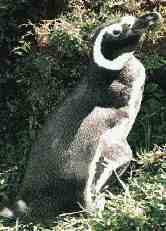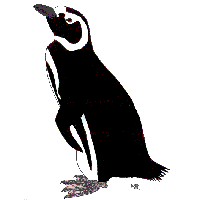


|
|
| |||



| ||||
. Magellanic Penguin by Mike Bingham Electronic download: $3.95 Paperback: $10.95 Proceeds fund our Research
Organisation for the Conservation of Penguins
Alvear 235
Casilla 263  |
|
.
Breeding Range: Chile, Argentina and Falkland Islands Magellanic penguins are found only in Chile, Argentina and the Falkland Islands. Population studies estimate that the world population of Magellanic penguins is about 1.7 million breeding pairs, with approximately 700,000 pairs in Chile, 900,000 pairs in Argentina and 100,000 pairs in the Falkland Islands (Bingham 2020). Breeding colonies range from north of Peninsula Valdes in Argentina, southwards down the entire coast of Patagonia, around the southern tip of South America, and northwards up the Pacific coast of Chile as far north as Chiloe.
 MAGELLANIC PENGUIN: Drawing by Mike Bingham The Magellanic Penguin is around 70cm long, and has an average weight of about 4.5kg. The head and upper parts are black apart from two broad white stripes beneath the throat; one running up behind the cheeks and above the eye to join the pink-coloured gape, the second running adjacent to the white under parts with which they merge above the legs. Females are slightly smaller than the males, but have similar plumage. The males have a slightly more pronounced forehead than the females, but the difference is very subtle and difficult to distinguish unless one is very familiar with the species. Penguins of the Genus Spheniscus, to which Magellanic, Humboldt and Galapagos Penguins all belong, are much more loosely colonial than other penguins. They generally nest in burrows when soil conditions permit, and are consequently spaced much further apart than surface-nesting penguins. Magellanic Penguin colonies in particular often extend over several kilometres of coastline, at densities ranging from 0.001 to 0.1 nests per sq.m. Magellanic Penguins are widely distributed throughout the Falkland Islands, both on East and West Falklands, and on offshore islands. Magellanic Penguins particularly like islands with tussac grass, and even very small tussac islands may hold colonies. The numerous offshore islands around Tierra del Fuego and the Pacific coast of Chile provide similar nesting habitat. By contrast, the main islands of East and West Falkland generally have very little remaining tussac grass as a result of livestock grazing, but Magellanic Penguins also nest on these coastal plains. These breeding sites have more in common with Patagonia, where livestock has also altered the natural vegetation. The largest breeding sites in South America are at Punta Tombo with 170,000 breeding pairs and Cabo Virgenes with 150,000 pairs (Bingham 2020). Magellanic Penguins excavate burrows in any suitable soil type, and when conditions do not favour burrowing they will nest on the surface in shallow depressions, cracks in rocks or under bushes. On Penguin Island in Argentina they even nest on the rocky surface mixed with Rockhopper Penguins, with no protection from the weather or predators. Adults arrive at the nest sites to breed in September, and after a period of burrow excavation and repair, they begin egg laying around mid October. Two equally sized eggs are laid 4 days apart, each with a weight of around 125g. Incubation takes about 42 days, with the male and female taking turns at incubating whilst the other goes to sea to forage. The average change-over period is about three days, with the main cause of nesting failure at this stage being the result of penguins abandoning the nest when their partner takes more than 8 days to return. Both parents continue to brood the chicks in turn, on a daily basis, for a period of 25 to 30 days. In most colonies the adults leave the colony in early morning, and return with food later the same day, with foraging trips lasting about 14 to 18 hours. However in the Falkland Islands the reduction of fish stocks caused by the commercial fishing industry means that the average foraging trip is well over 30 hours, with adults returning the following day and chicks getting fed once every two days. Magellanic Penguins mostly forage within about 40km from the nest site during chick rearing. By the end of 30 days the chicks have developed their mesoptile plumage, and are able to venture out of the burrows. At this stage they look very different from the adults, being a browny grey above, and creamy white below. Living in burrows, chicks have good protection from both predators and cold weather while both parents are away feeding, and consequently they do not form creches in the way that most surface-breeding species do. In colonies where the penguins nest under bushes, small creches can form when several penguins share a large bush. Whilst burrows offer good protection from most weather conditions, heavy rain can result in flooding of the burrows in some areas. Chicks rarely drown in such circumstances, but often become wet and cold. The situation can be worst when nests are made under bushes. Mesoptile plumage provides excellent insulation when dry, but it lacks the waterproofing qualities of the adult plumage and looses much of its insulation properties when wet. Consequently some chicks can die from hypothermia if heavy rain occurs shortly after hatching. Living in burrows also means that the chicks become infested with penguin fleas and ticks. Chicks and adults are able to groom themselves to get rid of these parasites over most of their body, but are unable to reach areas around the head and neck. If food is plentiful, adults are able to return to the nest late afternoon, which gives them plenty of time to groom the chicks to remove these parasites. However in the Falklands where adults have very little time to spend with the chicks due to the shortage of food, many chicks have so many parasites feeding on their blood that they become weak and anaemic. The two eggs hatch a few days apart and adults give feeding priority to the strongest chick, which is usually the first to hatch, resulting in a higher rate of mortality amongst second chicks. In nature it is better to have one strong chick than two weak ones. Nevertheless Magellanic Penguins do rear both chicks successfully when sufficient food can be caught. Normal healthy breeding success ranges from 0.8 to 1.6 chicks fledged per breeding pair, with just 1 chick per pair being necessary to sustain a healthy population. Magellanic Penguins do not usually re-lay if they loose their clutch. When the weather is fine larger chicks often sit outside their burrow entrances, but will rapidly return to the safety of their burrows at the first sign of danger. Fledging occurs at 9 to 17 weeks of age, depending on how much food they receive. Chicks are able to slow down their growth rate when food is less available in order to increase their chances of survival. Fledglings look similar to the adults, except for being greyer and lacking the clearly defined banding of the adults. After the chicks leave the colony, the adults spend a few weeks at sea, recovering the weight that they lost during chick rearing and feeding up in preparation for their annual moult during March, April or May. Moulting takes 3 to 4 weeks, after which the adults leave the breeding site, and migrate northwards as far as northern Brazil to avoid the short gloomy days of winter. The penguins remain at sea throughout their migration. Magellanic Penguins can live to over 30 years of age, with many individual birds having been monitored for well over 20 years of annual nesting. Females can begin breeding at 4 years of age, but the males do not normally breed until they are at least 5 years old. This is quite possibly a consequence of there being more males than females, making it easier for inexperienced females to find partners than for inexperienced males. Magellanic penguins generally show strong site and mate fidelity, and pair-bonds are reinforced by allopreening to get rid of each otherís parasites. Where food supply is not altered by commercial fishing, Magellanic penguins feed almost exclusively on fish. In the Straits of Magellan where large-scale commercial fishing is banned, over 90% of their diet is made up of just one species of fish (Sprattus fuegensis). In the Falkland Islands, the commercial fishing industry has forced the penguins to modify their diet, taking roughly equal proportions of fish (Micromesistius australis, Sprattus fuegensis, Engraulis anchoita, Merluccius hubbsi, Patagonotothen sp., Austroatherina sp., Myxinus sp.), squid (Loligo gahi, Gonatus antarcticus, Moroteuthis ingens, Onychoteuthis sp.) and Lobster Krill (Munidae gregaria). Lobster krill should not be fed to the chicks as it is too indigestible, but shortage of fish often forces penguins to do so. Many other substitutes fed to the chicks are also far less nutritious than fish (Bingham 2002). During chick-rearing, foraging trips are generally conducted on a daily basis during daylight hours, except in the Falklands where food is harder to find. Birds generally forage at depths of less than 50m, but on occasions may dive up to 100m. Winter foraging for prey takes them way beyond their normal breeding range. With no chicks to feed, the penguins have no need to remain close to their nests, and travel northwards as far as Brazil to avoid the short hours of daylight during the winter. Good light is important for penguins that catch fish by sight. Magellanic Penguins have declined severely in the Falkland Islands since the 1980's, which coincides with the establishment of the Falkland Islands commercial fishing industry for fish and squid. The current Falklands population of about 100,000 pairs stands at barely 8% of its pre-fishing industry level of over 1,300,000 pairs. This decline is still continuing. These declines have occurred in the Falklands, whilst nearby colonies in Chile and Argentina have increased.
Comparisons of colonies in the Falklands, Chile and Argentina confirm that competition with commercial fishing is the major cause of the Falklands decline. Adult penguins in Chile are able to return with food for their chicks on a daily basis, with foraging trips averaging 14 to 18 hours. By contrast adults in the Falkland Islands take approximately 35 hours to find the same amount of food. With only half the amount of food being fed to chicks, lower chick survival rates would be expected, and this is confirmed by our research. Over recent years breeding success and chick survival rates have been substantially higher in Chile and Argentina (average 1.2 chicks per nest) than in the Falklands (average 0.6 chicks per nest). This huge difference in breeding success is sufficient to account for the gradual decline in the Falklands population, with insufficient chicks being reared in the Falklands to replace natural adult mortality. Diet sample studies in areas with no commercial fishing show that Magellanic Penguins have a 90% dietary overlap with the Falkland Islands commercial fishing industry. In the Falklands, the lack of preferred prey caused by commercial fishing has forced Magellanic penguins to feed on squid and crustaceans, and their consumption of preferred species has been reduced to just 26%. Chicks are fed less food, and are fed on species that are at best less nutritious, and occasional harmful to chicks, as is the case of Lobster Krill. As a result the decline of Magellanic penguins has not levelled out in the way that it has for Gentoo and Rockhopper Penguins, and Magellanic penguins continue to decline in the Falkland Islands. The colony at Punta Tombo in Argentina has also experienced a decline as a result of commercial fishing for similar reasons. However further south Magellanic Penguin colonies have increased during the last 20 years. Population studies by the author show that many colonies in southern Argentina and Chile have had population increases since the 1990s, whilst the Falkland Islands was loosing 92% of its population. Fishing vessels are not the only man-made hazard faced by Magellanic Penguins. An active offshore oil and gas industry make pollution from oil a constant risk to penguins. Oil is discharged into the sea both through accidental spillage, and through deliberate operational discharge of oily ballast water from tankers. Oil exploration around the Falkland Islands could mean similar mortality amongst all species of Falklands penguins, unless considerably higher standards to those employed in Argentina are demanded. Unfortunately early indications are not good. During a 5 month period of oil exploration around the Falklands in 1998, no less than three oil spills occurred, killing several hundred penguins, cormorants and other seabirds. Magellanic Penguins face little natural predation at sea. The major predators of penguins, such as Leopard Seals, live further to the south nearer to Antarctica. Sea Lions do kill some penguins at some locations, but it does not appear to be normal predation in most cases. The Sea Lions that kill penguins are mostly single males that have been unable to secure females, and they rarely eat the penguins that they kill. Magellanic penguins have no predators on land, but they do face predation of their chicks and eggs by avian predators (such as skuas), foxes and armadillos. When the penguins nest in burrows this predation is greatly reduced. Magellanic penguins have a fierce bite that deters even large predators like foxes from coming near. Studies show that predation is reduced in the presence of tourists. The penguins adjust to the presence of people, whilst skuas, foxes and other predators do not, allowing penguins that breed in the presence of tourism to have slightly higher breeding success. The Dutch explorer Oliver van Noort records visiting Magdalena Island during the 16th Century, to collect penguin eggs for food. Egging of Magellanic Penguins used to occur in the Falkland Islands, but this has now virtually stopped. Magellanic Penguins are also occasionally killed by crab fishermen around the remoter parts of southern Chile, the penguin carcasses being used to bait crab pots. This activity is illegal but difficult to control since it occurs in remote locations. It has had little impact on the overall penguin population, since this crabbing industry is small scale, but it has seriously damaged some individual breeding sites. Magellanic Penguins are the most accessible penguins for tourism in South America. Visitors that approach breeding sites which do not normally have many visitors will send the penguins scurrying into their burrows for safety. However Magellanic Penguins readily adapt to regular visitation so long as there is a marked path that stops people from walking amongst the nests. Simple fences stopping people from walking amongst the nests is all that is needed, and this arrangement can benefit both penguins and tourists. Not only are the penguins protected from people stepping onto their nests, but they also rapidly learn that humans will not enter beyond the fence, and will confidently remain sitting outside their burrows for all to see. Many penguins become so used to visitors that they barely open an eye as people walk right by them, sometimes even sleeping within the tourist path. By contrast, visitors to unfenced sites will generally see little more than distant penguins scurrying away, or faces looking out from inside their burrows. In the Falkland Islands Magellanic Penguins prefer to nest amongst tussac grass for protection, but most of this has now been lost from the mainlands of East and West Falkland, as a result of over-grazing. Tussac grass does still remain on many of the offshore islands however, and efforts are now being made to fence off some mainland sites from livestock, in order to allow regeneration. In areas where this has been done, Magellanic Penguins are often quick to re-colonise, as can be seen around Gypsy Cove near Port Stanley. There is a certain degree of symbiosis between Magellanic Penguins and tussac grass. Not only do the penguins benefit from having dense cover for their nests, giving protection against predation and bad weather, but the tussac grass also benefits. Penguins feeding at sea later deposit their guano around the burrows, providing nutrients that promote lush growth. In addition, abandoned burrows create traps for seeds, where seedlings can get a foothold, and where they are partially sheltered during the initial stages of growth. This is particularly important in enabling tussac grass to colonise new areas, or enabling re-colonisation of old areas that had been converted to heathland by overgrazing.
CLICK HERE to Adopt a Penguin of your very own.
|